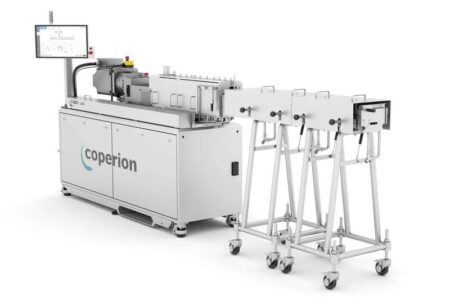Coperion donates food extruder to US university

The Coperion ZSK 27 Food Extruder in Hybrid Version entertained guests during live demonstrations held at the dedication event. The donation included two Coperion K-Tron loss-in-weight feeders for the addition of powders and liquids.
Coperion has donated a ZSK 27 food extruder in hybrid version with all the ‘bells and whistles’ to Purdue University for students and staff to conduct research on the new state-of-the-art extruder.
The extruder will be used by the Department of Food Science — College of Agriculture and the Food Entrepreneurship and Manufacturing Institute (FEMI) at the university in Indiana.
The co-rotating twin screw extruder includes the latest in controls capabilities, customised configurations and process parameters to allow the study of emerging markets such as plant-based meat substitutes, hemp, the production of cereals, snack foods including puff snacks, pet food and the development of many new extruded processed food products.
To complement the extruder, the donation includes two Coperion K-Tron loss-in-weight (LIW) feeders, for powders and liquids, designed with the latest generation of controls and load cells to ensure the highest accuracy of ingredient delivery to the extruder.
“This is a huge win for all, and Purdue is very excited about the partnership. The students and staff are ready to conduct research on the new state-of-the-art extruder with all the bells and whistles”, says Allison Kingery, executive director Life Science and Agriculture at Purdue University.
“The new extruder replaces a working 25-year-old Coperion extruder, but we are looking forward to having a new, up-to-date extruder that includes new controls and new technology. This is a major donation for the students; they will be able to say they have utilised a modern, highly engineered extruder while in school and will be that much further ahead when graduating. The students will certainly benefit from utilising a machine with such an exceptional reputation in the food industry.”
Kingery goes on to say that Purdue and Coperion already have companies eager to sign up for the use of the extruder, from smaller start-up companies to large corporations.
“The setup at the university includes a full-scale kitchen next to the plant. The addition of the extruder to the test lab will not only open opportunities for the testing of products but also will allow the study of the final extruded product to be used in the kitchen and basically bring the product to life,” Kingery says. “A full 360-degree loop from development, to research to design. Nutritional analysis will also be done at the university from the products produced by the extruder. This is such a broad opportunity for the students at the university.”
The Coperion ZSK 27 twin screw extruder in hybrid version offers a variety of options that ensure maximum flexibility and easy handling. The twin screw extruder’s stainless steel design fulfills the highest hygiene requirements and makes fast, efficient cleaning and recipe changes a reality.
The extruder consists of a modular process section with several barrels in which the co-rotating screws operate. The closely intermeshing screws with their tight, self-wiping profile eliminate stagnant zones over the whole length of the process section. The modular design and its unusual combination of free screw volume, screw speed and torque enable this twin screw extruder to be individually configured for every application. Due to this high flexibility, the extruder is suited for research tasks and recipe development. With its 10.6 Nm /cm3 specific torque and maximum screw speed of 1,800 min-1, the machine achieves throughputs of 10 to 100 kg/h, depending upon the end-product.
In addition, this food extruder in hybrid version can be used for manufacturing textured vegetable protein (TVP) and high moisture meat analogues (HMMA) on the same machine. The product’s final structure is created by using the Coperion ZGF centric food pelletiser for TVP or a cooling die for HMMA. Using an adapter solution, the extruder’s discharge can be switched from the centric pelletiser to the cooling die.



